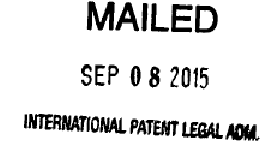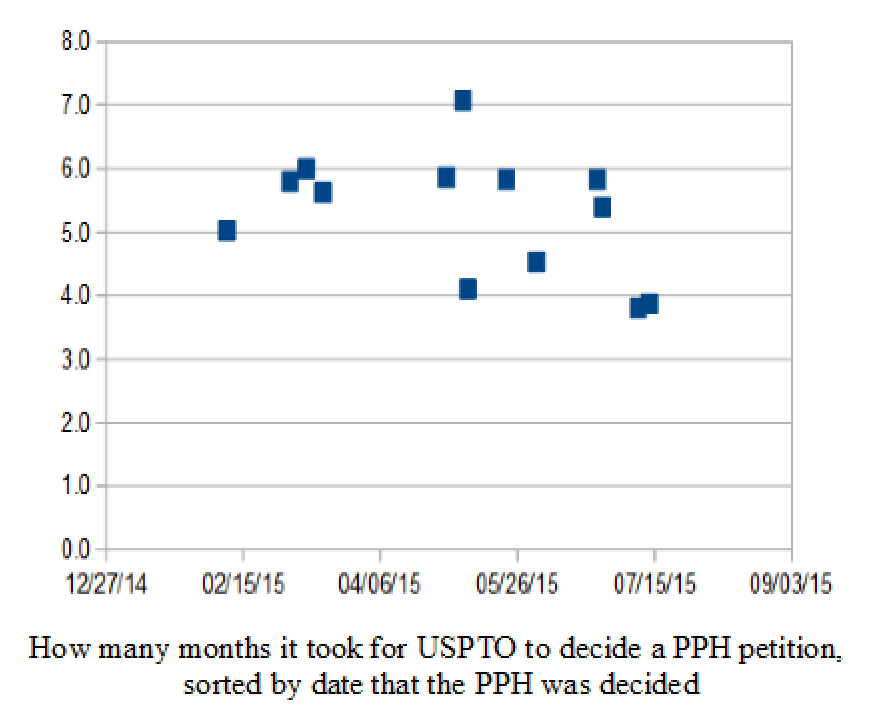Note: what seemed like an improvement at the USPTO regarding PPH petitions turned out to be illusory. Please see a followup article about this.
There are two ways to pursue US patent protection from a PCT patent ap plication:
plication:
- entry into the US national phase, and
- filing of a bypass continuation application,
and there are many factors which might influence a particular filer’s choice of one approach or the other. Now there is yet another factor, namely the speed with which a PPH petition might get granted. If you pick “US national phase”, your PPH petition will nowadays likely get decided in a few days rather than a few months. As I will describe below, a couple of weeks ago we filed about fifty PCT-PPH petitions, and we figured we would have to wait the usual four to seven months for USPTO to decide them. We were astonished when seven of these fifty PCT-PPH petitions got decided in less than three weeks. It turns out there is an easy explanation for this happy result.
Until very recently, for the past couple of years all PPH petitions (which included all PCT-PPH petitions) were getting routed within the USPTO to the Office of Patent Petitions. And the Office of Patent Petitions was fairly consistently aging each petition for six months before taking the petition up for decision. See this blog post from last March about a PCT-PPH petition which at that time had gone into its seventh month of waiting for OPP to do its job. And see this graph showing that as of July 2015, OPP (which claimed at the time to have gotten its backlog down to under four months) was still consistently taking anywhere from four to seven months to decide a PPH petition.
showing that as of July 2015, OPP (which claimed at the time to have gotten its backlog down to under four months) was still consistently taking anywhere from four to seven months to decide a PPH petition.
Back in April I faxed a letter to Director Lee asking that something be done to get PPH petitions decided less slowly. I never heard back from the Director in response to that letter. I also blogged a suggestion that since OPP was clearly not able to keep up with its workload, maybe the PCT-PPH petitions could be routed to the PCT Legal Administration office instead of routing them to OPP. (In recent months PCT Legal, now renamed Office of International Patent Legal Administration, has been keeping up with its workload much better than OPP.)
I don’t know whether my blog postings about this or my letter to Director Lee about this made any difference, but I was astonished in recent days to see that seven of our fifty recent PPH petitions had been granted within a mere three weeks of filing.
A quick look at the letters granting these PPH petitions made it easy to see why things were so different. These PPH petitions had not been routed to OPP. They had been routed to the Office of International Patent Legal Administration rather than to OPP. You can see the date-of-mailing stamp quoted above.
It looks like some time toward the beginning of August 2015, USPTO changed its business process rule so that in the special case where the PPH petition relates to a national-phase application, the PPH petition gets sent not to OPP as in the past but instead gets sent to OIPLA. And OIPLA is turning these things around in three weeks or less, rather than OPP’s delay of four months or more.
What I had hoped I might be able to find out from the USPTO is how exactly USPTO has modified its business process rule. How exactly does USPTO now decide whether to send a PPH petition to OIPLA? It is possible to imagine any of several approaches.
- One possibility would be to route the PPH petition based upon the application type as listed in Palm. So for example if the application is a 371 case (an entry into the US national phase) then the petition decision would be rendered by OIPLA rather than by OPP. Keep in mind that such a PPH petition might not be based upon PCT work product. For example the work product might be legacy Paris work product such as a notice of allowance from a non-US patent office. The indexing term selected by the filer might be “PPH petition” or “PCT-PPH petition”.
- Another possibility might be to route the PPH petition based upon the document description selected by the filer. If the filer were to pick “PCT-PPH petition” then the petition would go to OIPLA, while a “PPH petition” would go to OPP. Clearly this would motivate filers to pick “PCT-PPH petition” since this would forum-shop the petition to the office that does its work in three weeks instead of 4-7 months.
- A third possibility would be to route the PPH petition based upon manual scrutiny of the particular work product upon which the petitioner relies for Highway status. If the work product is PCT work product, send the petition to OIPLA.
Which of these business process rule changes did USPTO actually make in early August 2015? As I say I had hoped I might find this out from somebody at USPTO, but that has not happened.
The third approach (add a processing step in which somebody screens each newly filed petition to see what sort of work product was relied upon) seems unlikely to be the case. No way would USPTO have each petition touched twice by legally trained personnel.
The second approach also seems unlikely as it would enable forum-shopping and I’d guess USPTO would prefer to minimize opportunities for customers to forum-shop.
That leaves the first approach, that is, routing the PPH petition based simply upon the application type as listed in Palm. I’d guess that is the BPR selected by the USPTO in early August 2015. It has a first advantage that it is a bright-line standard that is easy to implement in software. It has a second advantage that it probably matches or closely matches whatever line as to jurisdictional turf had been previously negotiated between OIPLA and OPP.
As I say, in August we filed about fifty PPH petitions. Seven of them got decided within three weeks, having been routed to OIPLA. Meanwhile our PPH petitions that have been routed to OPP (all filed earlier than August 2015) are still taking four to seven months to get decided. For example we have a PPH petition that we filed in April of 2015 that sits even now in OPP without a decision.
Of our seven PPH petitions recently decided by OIPLA, three are in cases assigned to art unit 2464. Art unit 2464 is these days giving FOAPs (first office action predictions) of sixty months. This is a “pegged” prediction meaning that the true backlog is probably far worse than sixty months, but USPTO has made a policy decision never to report an FOAP number bigger than sixty.
It is very, very gratifying to imagine that some of the fifty PPH petitions that we filed in August of 2015 will lead to a client getting moved to the front of the line for examination, ahead of other applicants who will have to wait sixty months or more to see a first Office Action.
It is also very gratifying to imagine that the remaining forty-three PPH petitions that we filed in August of 2015 (all of which were in national-phase cases) will also get routed to OIPLA and will get decided promptly.
Which then leads to the opening paragraph of this blog. If a filer has a choice whether to file a US national-phase case or a bypass continuation, and if the filer is hoping to get Highway status promptly (rather than having to wait four to seven extra months to gain Highway status), then it looks like US national phase is the way to go.
